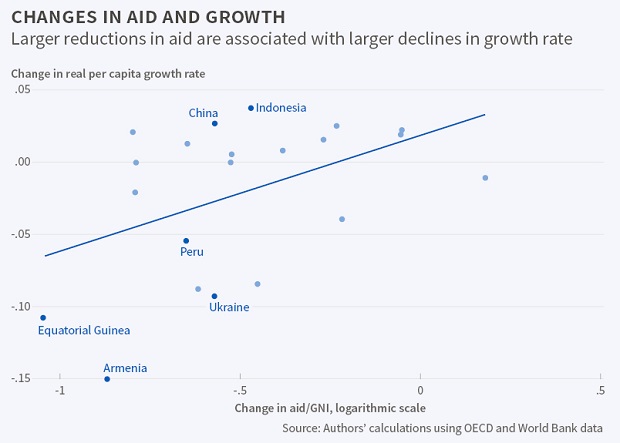News
Does foreign aid have a positive effect on growth?

The drop in aid experienced by countries after they cross a pre-defined income threshold provides opportunity to identify aid’s impact.
The effect of foreign aid on growth is the subject of ongoing debate. It is difficult to determine the effect of aid on growth when aid is an integral part of an economy; there are few “experiments” in the level of foreign aid.
The authors of a recent NBER Working Paper, The Effect of Aid on Growth: Evidence from a Quasi-Experiment, argue that there are points on a nation’s growth trajectory at which aid inflows drop because of the rules donors use to select recipient countries. They use the substantial changes in aid around this point to evaluate how aid affects growth, and they conclude that aid has a substantial positive effect.
Since 1987, the World Bank’s International Development Association (IDA) has defined income thresholds above which countries are generally deemed less needy than poor nations. Other large donors tend to follow the World Bank’s lead, and they also reduce funding when nations reach the IDA income threshold. Recipient nations’ foreign aid as a share of gross national income (GNI) falls an average 59 percent once they cross the threshold.
The researchers posit that if per capita gross domestic product (GDP) falls after aid is withdrawn, the decline can be used to infer the boost in GDP that the nations received while aid was still flowing in. For the 35 countries that crossed the IDA threshold between 1987 and 2010 – a group that ranges from China to Peru and India to Turkmenistan – they calculate that a one percentage point increase in the ratio of aid to GNI is associated with an increase of about 0.35 percentage points in per capita GDP. They are careful to point out that this is a short-run effect, and that longer-run effects of aid on growth are difficult to measure.

The Effect of Aid on Growth: Evidence from a Quasi-Experiment
The literature on aid and growth has not found a convincing instrumental variable to identify the causal effects of aid. This paper exploits an instrumental variable based on the fact that since 1987, eligibility for aid from the International Development Association (IDA) has been based partly on whether or not a country is below a certain threshold of per capita income. The paper finds evidence that other donors tend to reinforce rather than compensate for reductions in IDA aid following threshold crossings. Overall, aid as a share of gross national income (GNI) drops about 59 percent on average after countries cross the threshold.
Focusing on the 35 countries that have crossed the income threshold from below between 1987 and 2010, a positive, statistically significant, and economically sizable effect of aid on growth is found. A one percentage point increase in the aid to GNI ratio from the sample mean raises annual real per capita growth in gross domestic product by approximately 0.35 percentage points.
Introduction
Whether foreign aid causes economic growth in recipient countries is a highly debated research question. Identification of the causal effect of aid on growth has been elusive so far due to the endogeneity of aid in growth models. An instrumental variable is needed to address these problems. However, as Clemens et al. (2012) conclude in their recent assessment: “the aid-growth literature does not currently possess a strong and patently valid instrumental variable with which to reliably test the hypothesis that aid strictly causes growth.”
In this paper we contribute to this literature by instrumenting, in an economic growth equation, the endogenous aid variable exploiting a plausible quasi-experiment created by the income threshold set by IDA (International Development Association), the World Bank’s program of grants and concessionary loans to low-income countries. We exploit this new instrument to investigate the causal effect of aid on growth.
This income threshold has been used as a key criterion in allocating scarce IDA resources since 1987, and is adjusted annually only to take into account inflation. Other major donors also appear to use the IDA threshold as an informative signal about where development aid is most needed, and we show that total aid declines significantly once a recipient country crosses the IDA income threshold from below. The IDA threshold is nevertheless an arbitrary income level that does not necessarily represent any structural change in economic growth. Threshold crossing is thus a plausibly valid instrumental variable for aid over years for a recipient country in a panel data model that controls for initial income levels and also includes country and period effects (we group years into 8 three-year periods).




